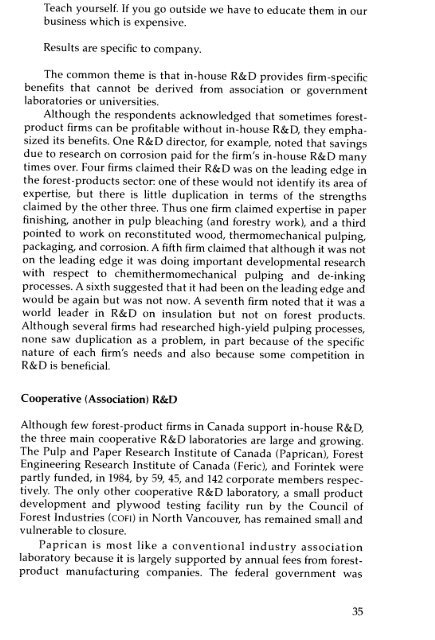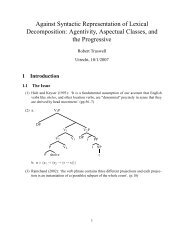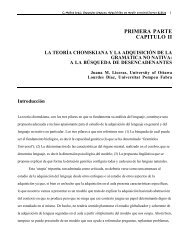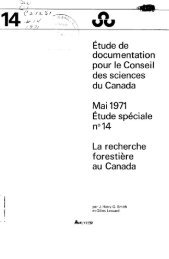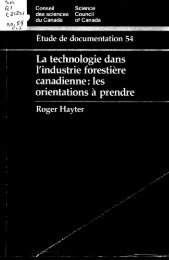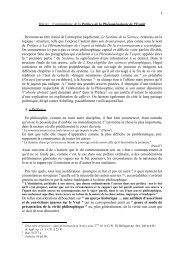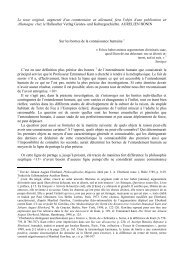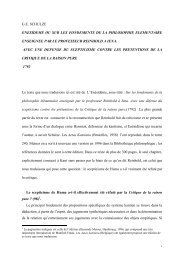Technology and the Canadian Forest-Product Industries ... - ArtSites
Technology and the Canadian Forest-Product Industries ... - ArtSites
Technology and the Canadian Forest-Product Industries ... - ArtSites
You also want an ePaper? Increase the reach of your titles
YUMPU automatically turns print PDFs into web optimized ePapers that Google loves.
Teach yourself. If you go outside we have to educate <strong>the</strong>m in ourbusiness which is expensive.Results are specific to company.The common <strong>the</strong>me is that in-house R&D provides firm-specificbenefits that cannot be derived from association or governmentlaboratories or universities.Although <strong>the</strong> respondents acknowledged that sometimes forestproductfirms can be profitable without in-house R&D, <strong>the</strong>y emphasizedits benefits. One R&D director, for example, noted that savingsdue to research on corrosion paid for <strong>the</strong> firm's in-house R&D manytimes over. Four firms claimed <strong>the</strong>ir R&D was on <strong>the</strong> leading edge in<strong>the</strong> forest-products sector: one of <strong>the</strong>se would not identify its area ofexpertise, but <strong>the</strong>re is little duplication in terms of <strong>the</strong> strengthsclaimed by <strong>the</strong> o<strong>the</strong>r three. Thus one firm claimed expertise in paperfinishing, ano<strong>the</strong>r in pulp bleaching (<strong>and</strong> forestry work), <strong>and</strong> a thirdpointed to work on reconstituted wood, <strong>the</strong>rmomechanical pulping,packaging, <strong>and</strong> corrosion. A fifth firm claimed that although it was noton <strong>the</strong> leading edge it was doing important developmental researchwith respect to chemi<strong>the</strong>rmomechanical pulping <strong>and</strong> de-inkingprocesses. A sixth suggested that it had been on <strong>the</strong> leading edge <strong>and</strong>would be again but was not now. A seventh firm noted that it was aworld leader in R&D on insulation but not on forest products.Although several firms had researched high-yield pulping processes,none saw duplication as a problem, in part because of <strong>the</strong> specificnature of each firm's needs <strong>and</strong> also because some competition inR&D is beneficial.Cooperative (Association) R&DAlthough few forest-product firms in Canada support in-house R&D,<strong>the</strong> three main cooperative R&D laboratories are large <strong>and</strong> growing.The Pulp <strong>and</strong> Paper Research Institute of Canada (Paprican), <strong>Forest</strong>Engineering Research Institute of Canada (Feric), <strong>and</strong> Forintek werepartly funded, in 1984, by 59, 45, <strong>and</strong> 142 corporate members respectively.The only o<strong>the</strong>r cooperative R&D laboratory, a small productdevelopment <strong>and</strong> plywood testing facility run by <strong>the</strong> Council of<strong>Forest</strong> <strong>Industries</strong> (COFI) in North Vancouver, has remained small <strong>and</strong>vulnerable to closure.Paprican is most like a conventional industry associationlaboratory because it is largely supported by annual fees from forestproductmanufacturing companies. The federal government was35


